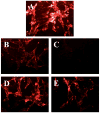"SMART" drug delivery systems: double-targeted pH-responsive pharmaceutical nanocarriers
- PMID: 16848401
- PMCID: PMC2538444
- DOI: 10.1021/bc060080h
"SMART" drug delivery systems: double-targeted pH-responsive pharmaceutical nanocarriers
Abstract
To develop targeted pharmaceutical carriers additionally capable of responding to certain local stimuli, such as decreased pH values in tumors or infarcts, targeted long-circulating PEGylated liposomes and PEG-phosphatidylethanolamine (PEG-PE)-based micelles have been prepared with several functions. First, they are capable of targeting a specific cell or organ by attaching the monoclonal antimyosin antibody 2G4 to their surface via pNP-PEG-PE moieties. Second, these liposomes and micelles were additionally modified with biotin or TAT peptide (TATp) moieties attached to the surface of the nanocarrier by using biotin-PE or TATp-PE or TATp-short PEG-PE derivatives. PEG-PE used for liposome surface modification or for micelle preparation was made degradable by inserting the pH-sensitive hydrazone bond between PEG and PE (PEG-Hz-PE). Under normal pH values, biotin and TATp functions on the surface of nanocarriers were "shielded" by long protecting PEG chains (pH-degradable PEG(2000)-PE or PEG(5000)-PE) or by even longer pNP-PEG-PE moieties used to attach antibodies to the nanocarrier (non-pH-degradable PEG(3400)-PE or PEG(5000)-PE). At pH 7.4-8.0, both liposomes and micelles demonstrated high specific binding with 2G4 antibody substrate, myosin, but very limited binding on an avidin column (biotin-containing nanocarriers) or internalization by NIH/3T3 or U-87 cells (TATp-containing nanocarriers). However, upon brief incubation (15-30 min) at lower pH values (pH 5.0-6.0), nanocarriers lost their protective PEG shell because of acidic hydrolysis of PEG-Hz-PE and acquired the ability to become strongly retained on an avidin column (biotin-containing nanocarriers) or effectively internalized by cells via TATp moieties (TATp-containing nanocarriers). We consider this result as the first step in the development of multifunctional stimuli-sensitive pharmaceutical nanocarriers.
Figures








Similar articles
-
Multifunctional PEGylated 2C5-immunoliposomes containing pH-sensitive bonds and TAT peptide for enhanced tumor cell internalization and cytotoxicity.J Control Release. 2012 Jun 10;160(2):264-73. doi: 10.1016/j.jconrel.2011.12.002. Epub 2011 Dec 13. J Control Release. 2012. PMID: 22182771 Free PMC article.
-
Environment-responsive multifunctional liposomes.Methods Mol Biol. 2010;605:213-42. doi: 10.1007/978-1-60327-360-2_15. Methods Mol Biol. 2010. PMID: 20072884 Free PMC article.
-
"Smart" drug carriers: PEGylated TATp-modified pH-sensitive liposomes.J Liposome Res. 2007;17(3-4):197-203. doi: 10.1080/08982100701525035. J Liposome Res. 2007. PMID: 18027240 Free PMC article.
-
Tat peptide-mediated intracellular delivery of pharmaceutical nanocarriers.Adv Drug Deliv Rev. 2008 Mar 1;60(4-5):548-58. doi: 10.1016/j.addr.2007.10.008. Epub 2007 Nov 28. Adv Drug Deliv Rev. 2008. PMID: 18053612 Review.
-
Tatp-mediated intracellular delivery of pharmaceutical nanocarriers.Biochem Soc Trans. 2007 Aug;35(Pt 4):816-20. doi: 10.1042/BST0350816. Biochem Soc Trans. 2007. PMID: 17635155 Review.
Cited by
-
Stimulus-responsive nanopreparations for tumor targeting.Integr Biol (Camb). 2013 Jan;5(1):96-107. doi: 10.1039/c2ib20135f. Integr Biol (Camb). 2013. PMID: 22869005 Free PMC article. Review.
-
Varying polymer architecture to deliver drugs.AAPS J. 2007 Jun 22;9(2):E235-40. doi: 10.1208/aapsj0902026. AAPS J. 2007. PMID: 17907764 Free PMC article. Review.
-
Smart Microneedles with Porous Polymer Coatings for pH-Responsive Drug Delivery.Polymers (Basel). 2019 Nov 7;11(11):1834. doi: 10.3390/polym11111834. Polymers (Basel). 2019. PMID: 31703443 Free PMC article.
-
Multifunctional and stimuli-sensitive pharmaceutical nanocarriers.Eur J Pharm Biopharm. 2009 Mar;71(3):431-44. doi: 10.1016/j.ejpb.2008.09.026. Epub 2008 Oct 17. Eur J Pharm Biopharm. 2009. PMID: 18977297 Free PMC article. Review.
-
pH-sensitive and folic acid-targeted MPEG-PHIS/FA-PEG-VE mixed micelles for the delivery of PTX-VE and their antitumor activity.Int J Nanomedicine. 2017 Aug 16;12:5863-5877. doi: 10.2147/IJN.S141982. eCollection 2017. Int J Nanomedicine. 2017. PMID: 28860753 Free PMC article.
References
-
- Maeda H, Wu J, Sawa T, Matsumura Y, Hori K. Tumor vascular permeability and the EPR effect in macromolecular therapeutics: a review. J Control Release. 2000;65:271–84. - PubMed
-
- Palmer TN, Caride VJ, Caldecourt MA, Twickler J, Abdullah V. The mechanism of liposome accumulation in infarction. Biochim Biophys Acta. 1984;797:363–8. - PubMed
-
- Jaracz S, Chen J, Kuznetsova LV, Ojima I. Recent advances in tumor-targeting anticancer drug conjugates. Bioorg Med Chem. 2005;13:5043–54. - PubMed
-
- Gabizon A, Shmeeda H, Horowitz AT, Zalipsky S. Tumor cell targeting of liposome-entrapped drugs with phospholipid-anchored folic acid-PEG conjugates. Adv Drug Deliv Rev. 2004;56:1177–92. - PubMed
Publication types
MeSH terms
Substances
Grants and funding
LinkOut - more resources
Full Text Sources
Other Literature Sources
Miscellaneous

